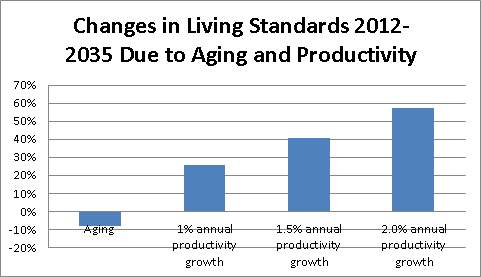November 29, 2012
Yes, things are really dire. Readers of the NYT, Washington Post and other major news outlets have been treated to large numbers of stories in recent months telling us that technology is going to make large segments of our workforce obsolete. According to these stories millions, or even tens of millions, of people will be unable to find jobs in the economy of the future.
But wait, it’s getting even worse. Not only are we not going to have enough jobs, the Post now tells us that we will not have enough people. It reports on a new study showing that the United States had the lowest birth rate since 1920 last year. The article tells us:
“The decline could have far-reaching implications for U.S. economic and social policy. A continuing decline would challenge long-held assumptions that births to immigrants will help maintain the U.S. population and provide the taxpaying work force needed to support the aging baby boomer generation.”
So there you have it, not only will we not have enough jobs, the Post is telling us that we won’t have enough people. It can’t get much worse than that!
This shows us the level of seriousness of Washington policy debates. We are supposed to be simultaneously terrified by diametrically opposite problems. To make this as clear as possible, just in case any Washington Post editors are reading, if we have a shortage of labor due to a slow growing or even declining population, then we don’t have to worry about large numbers of workers being unable to find jobs. There will be a labor shortage. This implies rapidly rising wages and employers who are willing to provide whatever training workers need to do the jobs available.
This means that at least one of the grave problems currently being pushed by the Serious People does not exist. A little arithmetic (a skill in short supply in policy circles) should make it clear that inadequate population growth is not going to be a dire problem. The figure below compares the impact on workers’ living standards of the projected increase in the ratio of workers to retirees over the next twenty three years with various rates of productivity growth. (You can find the explanation for the calculation here.)

Source: Author’s calculations.
The basic story is that even a 1.0 percent rate of productivity growth (the slowest we’ve seen in the post-War period) swamps the impact of demographics on living standards. Of course if technology is going to displace huge numbers of workers, as we’re being told, then we will see much more rapid productivity growth so the relative impact of demographics will be even less important.
In short the demographic scare story is sheer silliness. It is of course unfortunate if people who would like children feel that they are too financially insecure to have them, but the idea that we should be troubled by a less crowded, less polluted country? As they say in our nation’s capitol, only in the Washington Post.







Comments